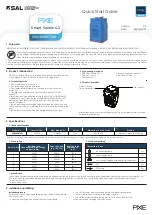
Chapter 4: Web management
NS3550-8T-2S Industrial Managed Switch User Manual
53
30 us for other link speeds. EEE devices must agree upon the value of the wakeup time
in order to make sure that both the receiving and transmitting device has all circuits
powered up when traffic is transmitted. The devices can exchange wakeup time
information using the LLDP protocol.
For maximizing power savings, the circuit isn't started at once when transmit data is
ready for a port, but is instead queued until 3000 bytes of data is ready to be
transmitted. For not introducing a large delay in case that data less than 3000 bytes
shall be transmitted, data is always transmitted after 48 us, providing a maximum
latency of 48 us plus the wakeup time.
If required, it is possible to minimize the latency for specific frames by mapping the
frames to a specific queue (done with QOS), and then mark the queue as an urgent
queue. When an urgent queue acquires data to be transmitted, the circuits will be
powered up at once and the latency will be reduced to the wakeup time.
EEE works for ports in auto-negotiation mode, where the port is negotiated to either 1G
or 100 Mbps full duplex mode.
The page includes the following fields:
Object
Description
Port
The switch port number of the logical EEE port,
*
means to select all
ports of industrial managed switch.
EEE Enable
Controls whether or not EEE is enabled for this switch port.
EEE Urgent Queues
Queues set activate transmission of frames as soon as any data is
available. Otherwise, the queue postpones the transmission until
3000 bytes, are ready to be transmitted.
















































